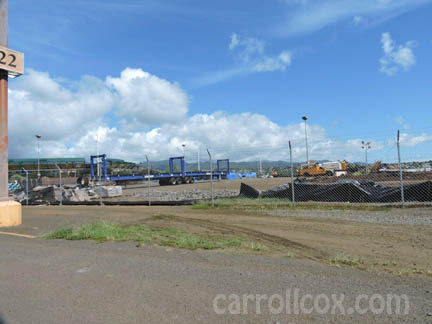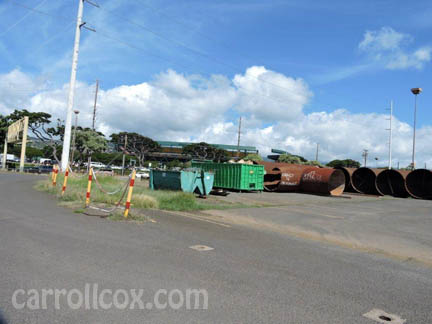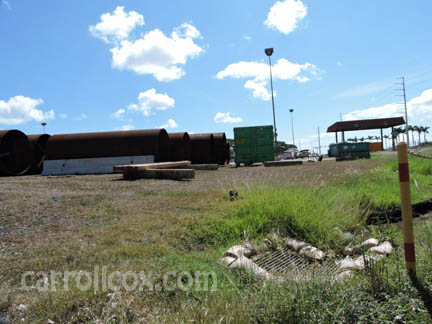|
|
THE STADIUM AND THE RAIL
|
Link here to "Investigation of the Stadium Authority’s Swap Meet Operations", March 2012
Link here to "Aloha Stadium Comprehensive Site Summary", June 26, 2014
RESPONSE FROM HART:
Subject: Your Inquiry
From: "Honolulu Transit Team" <info@honolulutransit.org>
Date: Fri, October 10, 2014 7:23 pm
To: carrollcox@carrollcox.com
Aloha Mr. Cox,
In response to your call to the rail project hotline and subsequent email regarding the
interface of the rail transit stop and the Aloha Stadium, the matter is
addressed in the project’s Final Environmental Impact Statement (EIS), Chapter
5, Section 5.5.1. You can find the Final EIS under Environmental Clearances in
the Library section of our project website www.honolulutransit.org. The subject of
locating a rail transit stop at the Aloha Stadium was determined acceptable
because transit is deemed a supportive use to the recreational uses of the
facility.
Thank you for your inquiry,
HART


RESONSE FROM HAWAII STADIUM AUTHORITY
From: Scott.L.Chan@hawaii.gov
Date: Fri, October 10, 2014 7:34 pm
To: carroll@carrollcox.com
Cc: cttoguchi@aol.com
Aloha Mr. Cox,
Attached you will find our response letter along with supporting documents addressing your email.
Thank you for your inquiry. Have a great weekend.
Aloha,
Scott
ATTACHED DOCUMENTS:
STADIUM RESPONSE TO CARROLL'S QUESTIONS
REQUEST FOR EXTENSION OF USE - 7/30/14
NATIONAL PARK SERVICE LETTER REGARDING USE OF SITE - 4/5/13
----- Forwarded by Scott L Chan/DAGS/StateHiUS on 10/10/2014 03:15 PM -----
From: Diana C Ho/DAGS/StateHiUS
To: Scott L Chan/DAGS/StateHiUS@StateHiUS,
Date: 10/07/2014 01:49 PM
Subject: Fw: Questions regarding the Aloha Stadium and Rail related use.
Diana C. Ho
Stadium Secretary
Aloha Stadium
PH; 808-483-2750
----- Forwarded by Diana C Ho/DAGS/StateHiUS on 10/07/2014 01:48 PM -----
From: <carrollcox@carrollcox.com>
To: info@honolulutransit.org, alohastadium@hawaii.gov,
Cc: "Carroll Cox" <carroll@carrollcox.com>
Date: 10/07/2014 01:34 PM
Subject: Questions regarding the Aloha Stadium and Rail related use.
October 7, 2014
Aloha Mr. Brennan,
and
Honolulu Stadium Authority
It was a pleasure speaking with you earlier today regarding the rail related activities occurring on the Honolulu Stadium property, and a Hawaii State Auditors Report dated March 2012, titled "Investigation of the Stadium Authority's Swap Meet Operations".
I would like to ask your assistance in obtaining information regarding the use of the stadium for rail related activities. For your convenience I have included excerpts from the auditor's report. I will be discussing this matter on my show this Sunday, October 12, 2014, and would greatly appreciate a reply by the end of the work day on Friday, October 10, 2014.
Has an alternate definition of recreational activities been issued? If yes, when was it issued? please provide a copy of the new definition.
Has a determination by the National Park Service determined that the proposed uses does or doesn't fit within the definition of recreational activities state and city's plans? If Yes, Please provide a copy of that determination.
The Auditors report states "By September 2011, the park service indicated it would support the non-exclusive easement because the transit stop can support the purposes of the park. It expressed concerns, however, about more elaborate development of the site and reserved the right to review the plans again." Have any plans been submitted by your agency, or other agencies for the National Parks' review to address the concerns by the National Parks?
Recent news reports claim that a new site will be picked for the stadium. If a new site is picked how will that effect the original site of the stadium and it's deed restrictions? Will the city or state continue to use the land as a recreational site? If yes, how will the rail related activity comply with the original deed restrictions?
Thank you,
Carroll Cox
The Auditor's Report states the following:
"Chapter 2
Stadium Authority Lax on Promises to U.S. Government and in Overseeing Swap Meet Operations
The Stadium Authority has been ineffective in guiding and managing
its swap meet operations. We found that the board neglected to notify
and seek federal approval of changes to swap meet operations over the
years, an obligation it agreed to when it purchased the stadium lands.
Much of the land underneath the swap meet operations is federal surplus
land with the restriction that it “be used only for public park or public
recreational use in perpetuity” and that “commercial purposes are not
allowed.” The federal government has indicated its concern that swap
meet operations, now a bustling commercial enterprise, may violate
federal use restrictions.
Moreover, the board and its stadium manager have surrendered
management responsibilities to their swap meet contractor, Centerplate,
which operates with little oversight. By failing to provide leadership and
guidance and adequate contract administration, authority officials have
allowed Centerplate to make unilateral changes to swap meet operations,
upsetting vendors. Also, Centerplate’s failure to consistently enforce
its rules allowed swap meet vendors to operate illegally and avoid state
general excise tax obligations.
1. Lack of federal approval for the use of the Aloha Stadium lands puts
swap meet operations and future plans at risk.
2. Stadium Authority has surrendered its management responsibilities
to a private contractor, which operates with little oversight.
The Stadium Authority has always known that portions of the stadium
lands are subject to federal use restrictions. In the 1970s, when the State
received title from the City and County of Honolulu, it obtained approval
from the federal government to develop the stadium and operate a swap
meet concession. Since that time, the authority has not been vigilant in
notifying the federal government of changes to the use. As a result, its
current swap meet operations have not been approved and may violate
a strict bar on commercial use. Moreover, federal approval has not yet
been obtained for future projects, such as the development of a transit
station the city needs for its rail project.
Portions of the stadium swap meet and marketplace operate on lands that
are subject to federal use restrictions. These restrictions, which require
that the parcel be used for public park or public recreational use, prohibit commercial activities unless prior approval is obtained from the federal government. The Stadium Authority, however, did not obtain approval to operate its current swap meet and marketplace. Without it, the authority is in noncompliance with the use restrictions and risks loss of the swap meet and marketplace and its revenue. Noncompliance could lead to reversion of stadium lands to the federal government.
Authority agreed to maintain stadium lands as public recreational area. The stadium lands originally belonged to the federal government. In 1967, the City and County of Honolulu purchased the lands from the federal government for a stadium park, including a stadium structure, its parking facilities, and an adjacent public park for the recreational enjoyment of the residents of the surrounding area. The city promised that the “land [would] be forever used and maintained as public
recreational area (public park or historic monument) and for that purpose
only.” This intended use—known as a program of utilization—was
approved by the U.S. Department of the Interior.
In 1970, the city transferred the stadium lands to the State by a quitclaim
deed. The Department of the Interior, Bureau of Outdoor Recreation,
approved a change to the original program of utilization to allow “the
State to build the Aloha Stadium on the property for public recreational
use.” A copy of the quitclaim deed between the City and County of
Honolulu and State of Hawai‘i is attached as Appendix A. A 2009
memorandum of understanding between the State and the National Park
Service summarized the terms of the quitclaim deed:
The land must be used only for public park or public recreational use in perpetuity according to a program of utilization approved by the National Park Service.
Concession agreements may be entered into for the purpose of serving a public park and recreation purpose, but commercial purposes are not allowed.
(emphasis added.)
To acquire title, the State also agreed to submit biennial compliance
reports until 1987, setting forth the use made of the property, including
information about any proposed modifications or changes to the program
of utilization. In the event of a breach, the State’s title to the property,
together with all the improvements, reverts to the United States upon
written demand by the Secretary of the Interior.
We reviewed the stadium lands and found that the swap meet and
marketplace operates on lands subject to federal use restrictions. The
swap meet and marketplace is situated in the parking lot that encircles
the arena as shown in Exhibit 1.5. Exhibit 2.1 shows the federal land
under the stadium arena and surrounding parking lot outlined in red. The
swap meet and marketplace occupy most of rows C and D inside the red
line. Given this placement, the Stadium Authority is obligated to seek
prior approval from the Secretary of the Interior for use of the land for
these operations. Lacking approval or in the event the authority cannot
get approval, the secretary could compel the authority to eliminate the
swap meet and marketplace or, in the alternative, demand reversion of
the lands and the stadium to the United States.
Exhibit 2.1
Map Showing Placement of Swap Meet and Marketplace Operations on Federal Lands
No record found of federal approval for current swap meet and
marketplace activities:
Previous swap meet operations had federal approval to operate on
stadium lands. In 1977, the stadium manager proposed a Sunday
morning swap meet concession “to round out the use of this property
during off hours.” A copy of the stadium manager’s proposal describing
the swap meet is attached as Appendix B. At that time, the U.S.
Department of the Interior, Bureau of Outdoor Recreation, administered
the Federal Land to Parks Program and the bureau’s western regional
director approved the swap meet concession for a two-year period from
1977-1979. The first swap meet included 50 vendors and was located
in the stadium parking lot. The swap meet concession ended after ten
months for lack of public support.
In 1979, the stadium manager requested approval to renew the swap
meet. Administration of the federal program had since moved to the
U.S. Department of the Interior, Heritage Conservation and Recreation
Service. The department approved the stadium manager’s request with
the understanding that “renewed swap meet activities will be similar
to those originally approved . . . and will not conflict with regularly
scheduled events at the stadium.”
The 1979 approval apparently was the last federal approval for a swap
meet. Neither the stadium manager nor the National Park Service—the
agency currently in charge of administration of the federal program—has
records of subsequent approval or notification of changes to swap meet
operations since that time. Thus, it appears that the Stadium Authority
failed to notify the National Park Service of changes in the frequency
and size of the swap meet and marketplace activities over the past three
decades.
Swap meet and marketplace’s commercial activities unlikely to
satisfy deed restrictions.
The federal deed restrictions require that the stadium lands be used and
maintained as a public recreational area. As such, commercial uses are
not allowed, and any concessions must receive prior approval and serve
a public park and recreational purpose. Although swap meet concessions
have been approved in the past, the current swap meet contractual
arrangement has not. More importantly, we found that the current swap
meet and marketplace’s operations may violate federal use restrictions
because they are commercial activities that neither directly relate to nor
support public recreational use.
In 1999, the authority changed the swap meet arrangement from a
concession agreement to a service contract. Also, the name—Aloha Flea
Market—was changed to Aloha Stadium Swap Meet. The name changed
again in 2008 to Aloha Stadium Swap Meet and Marketplace. These changes to the swap meet, however, were never shared with the National Park Service. Upon hearing a description of swap meet and marketplace activities in 2009, the Federal Lands to Parks Program coordinator, an official with the National Park Service, agreed that it may have evolved into something entirely different from the swap meet concessions approved in the past.
The federal coordinator expressed doubt that the commercial activities occurring in today’s swap meet and marketplace would satisfy the deed restrictions and public recreational purpose. He stated that a swap meet would push the boundary of what is acceptable to the agency, but may meet the deed requirements if:
1. It is a public event;
2. It is not a commercial operation;
3. Its use is limited; and
4. Its operation does not remove the property from public recreational use.
Although it is a public event that does not remove the stadium property from public recreational use, thereby satisfying the first and fourth criteria, it is largely a commercial operation, which violates the second. Specifically, the swap meet and marketplace does not directly support a recreational activity and, hence, cannot qualify as a concession. For example, according to the federal coordinator, a kayak rental in a park with lakes and streams would qualify as a concession because people rent kayaks for recreational use. On the other hand, a car rental would not qualify because it does not directly support a recreational activity. As to the third criterion—limited use —the swap meet and marketplace is open for business on more days throughout the year than a combination of all other events held at the stadium. This does not comport with a criterion of limited use. For example, the 1977 swap meet concession approval was for Sunday mornings and an occasional weekday morning not to conflict with scheduled events within the stadium. In total, about 50 to 60 swap meet events per year were allowed. By 1981, nearly 100 swap meet events were held each year, almost double the number of events approved in 1977. By 1991, the number of swap meet days had nearly tripled to three days per week. As shown in Exhibit 2.2, in fiscal years 2007 through 2010 there were almost 160 swap meet days each year. By comparison, in FY2007, there were 137 spectator events held in the stadium. The number of spectator events held in the stadium has dropped each year since then to 94 spectator events held in FY2010.
Loss of land swap
to remove use
restrictions may put
State’s and city’s plans
at risk
In 1992, Congress enacted a law to authorize the Secretary of the Interior to remove the stadium property use restrictions. That same year, Hawai‘i’s governor and the mayor of Honolulu in a joint letter wrote to the secretary requesting to remove the covenant to use and maintain the stadium lands “forever and continuously . . . as and for a public park and public recreation area . . . only.” At that time, the State and the city planned to use the lands for affordable housing, transit stations, and state offices.
More than 15 years later, in January 2009, the State executed a
memorandum of understanding with the National Park Service “to establish requirements for a land exchange, and the process by which the NPS and the State will explore the possibility of a land exchange fo the Aloha Stadium property.” The lifting of the restrictions would not be effective until an equal amount of additional land is identified and dedicated for a public park and public recreation uses. At that time, the State sought to allow commercial use of the stadium lands and public-private partnerships to fund needed repairs and the rebuilding of Aloha Stadium. Also, the city sought to use the Aloha Stadium’s Kamehameha parking lot for a transit station to serve approximately 700 vehicles as part of the city’s Honolulu High Capacity Transit Corridor.
During 2009 and 2010, the then-state comptroller led the effort to complete land appraisals and identify properties for the land swap. By December 2010, however, the swap was no longer an option because the stadium property without the deed restriction was valued at $33.3 million, and the State could not designate property of equal value as required by the federal government. When the authority lost the land swap option, it determined to obtain an alternate definition of recreational
activities from the National Park Service. As of August 2011, no response from the service has been received.
In addition, in March 2011, shortly after the City and County of Honolulu conducted a ground-breaking ceremony to signal the start of its transit corridor project, the State requested a teleconference call with the National Park Service and the city to seek the service’s concurrence with the State’s issuance of a revocable limited right-of-entry to the city for its transit corridor. By September 2011, the park service indicated it would support the non-exclusive easement because the transit stop can support the purposes of the park. It expressed concerns, however, about more elaborate development of the site and reserved the right to review the plans again.
Although the right-of-entry and easement issues related to the city’s transit corridor project are almost resolved, the State has yet to receive an alternate definition of recreational activities. A determination by the National Park Service that the proposed uses do not fit within the definition of recreational activities may put at risk or curtail both the State’s and the city’s plans.
